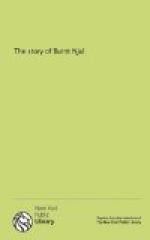Against the wainscot in various parts of the hall, shields and weapons were hung up. It was the sound of Skarphedinn’s axe against the wainscot that woke up Njal and brought him out of his shut bed, when his sons set out on their hunt after Sigmund the white and Skiolld.
Now let us pass out of the skali by either door, and cast our eyes at the high gables with their carved projections, and we shall understand at a glance how it was that Mord’s counsel to throw ropes round the ends of the timbers, and then to twist them tight with levers and rollers, could only end, if carried out, in tearing the whole roof off the house. It was then much easier work for Gunnar’s foes to mount up on the side-roofs as the Easterling, who brought word that his bill was at home, had already done, and thence to attack him in his sleeping loft with safety to themselves, after his bowstring had been cut.
Some homesteads, like those of Gunnar at Lithend, and Gisli and his brother at Hol in Hawkdale, in the West Firths, had bowers, ladies’ chambers, where the women eat and span, and where, in both the houses that we have named, gossip and scandal was talked with the worst results. These bowers stood away from the other buildings....
Every Icelandic homestead was approached by a straight road which led up to the yard round which the main building and its out-houses and farm-buildings stood. This was fenced in on each side by a wall of stones or turf. Near the house stood the “town” or home fields where meadow hay was grown, and in favoured positions where corn would grow, there were also enclosures of arable land near the house. On the uplands and marshes more hay was grown. Hay was the great crop in Iceland; for the large studs of horses and great herds of cattle that roamed upon the hills and fells in summer needed fodder in the stable and byre in winter, when they were brought home. As for the flocks of sheep, they seem to have been reckoned and marked every autumn, and milked and shorn in summer; but to have fought it out with nature on the hill-side all the year round as they best could. Hay, therefore, was the main staple, and haymaking the great end and aim of an Icelandic farmer.... Gunnar’s death in our Saga may be set down to the fact that all his men were away in the Landisles finishing their haymaking. Again, Flosi, before the Burning, bids all his men go home and make an end of their haymaking, and when that is over, to meet and fall on Njal and his sons. Even the great duty of revenge gives way to the still more urgent duty of providing fodder for the winter store. Hayneed, to run short of hay, was the greatest misfortune that could befall a man, who with a fine herd and stud, might see both perish before his eyes in winter. Then it was that men of open heart and hand, like Gunnar, helped their tenants and neighbours, often, as we see in Gunnar’s case, till they had neither hay nor food enough left for their own household, and had to buy or borrow from those that had. Then, too, it was that the churl’s nature came out in Otkell and others, who having enough and to spare, would not part with their abundance for love or money.




